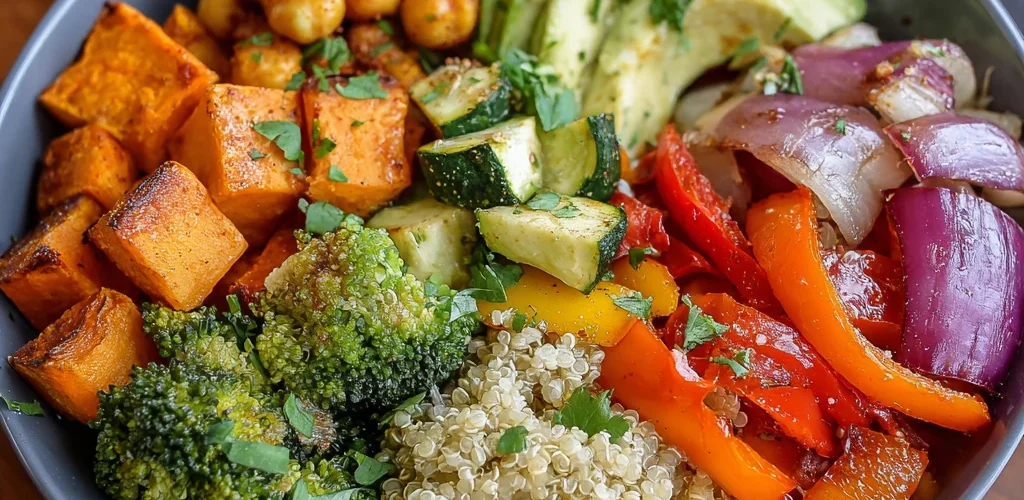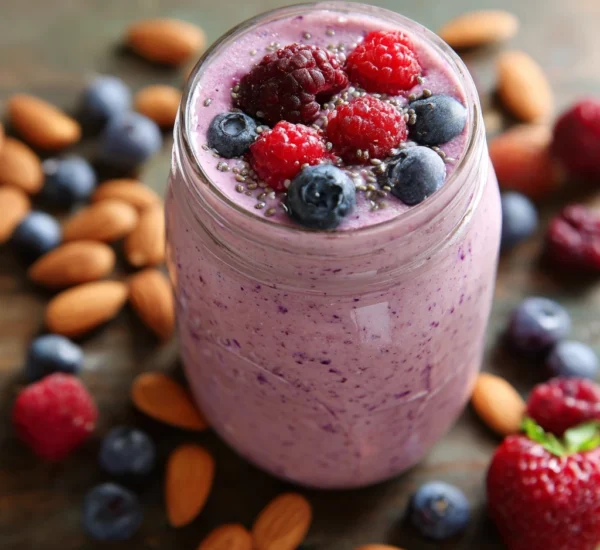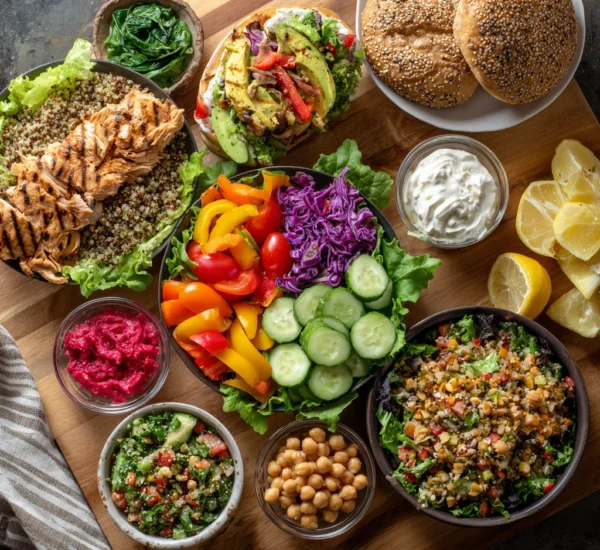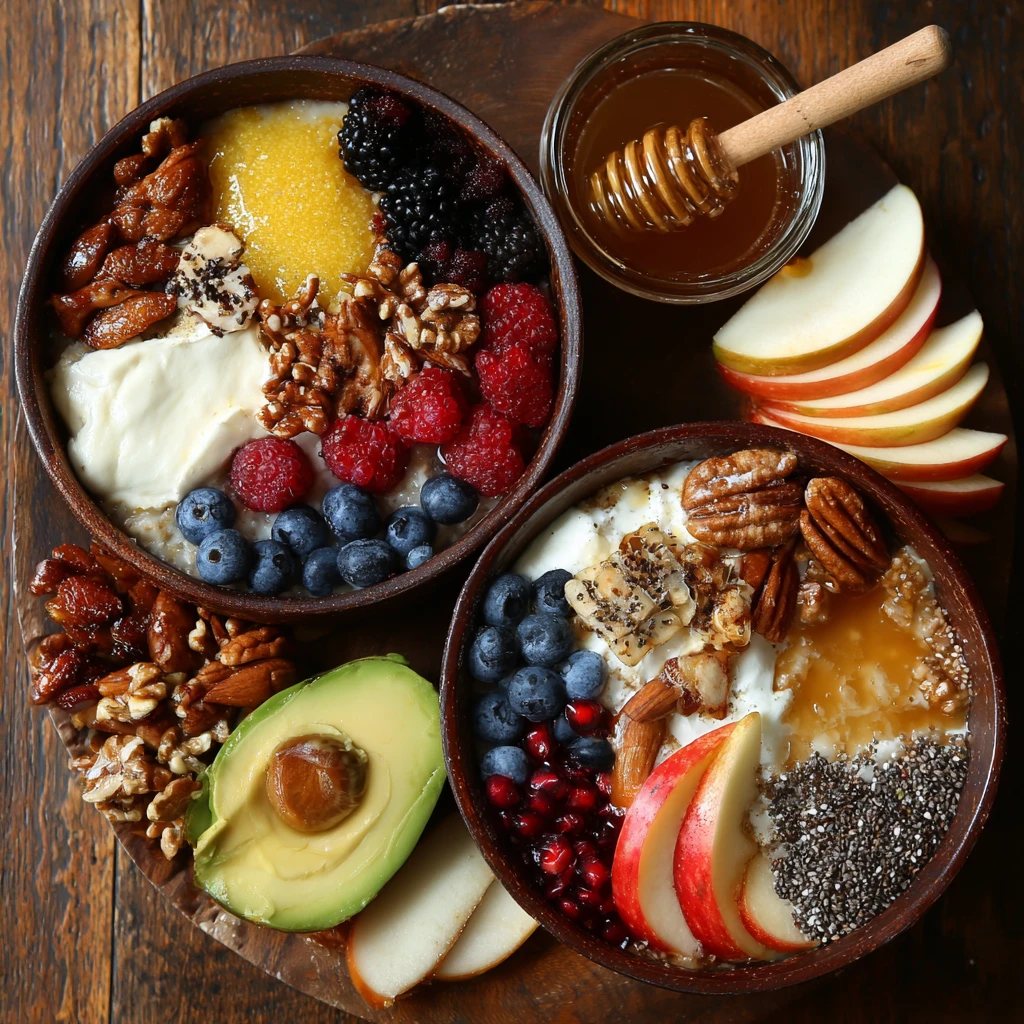Quinoa and Roasted Vegetable Bowl: A Healthy and Delicious Meal
Quinoa and roasted vegetable bowls are a vibrant and nourishing meal option, perfect for a quick lunch, satisfying dinner, or healthy meal prep. Packed with protein, fiber, and a rainbow of vitamins and minerals, this bowl is as good for you as it tastes. This article will guide you through creating the perfect quinoa and roasted vegetable bowl, exploring ingredient options, cooking techniques, and delicious variations.

Mastering the Art of Roasted Vegetables
The foundation of a great quinoa and roasted vegetable bowl lies in perfectly roasted vegetables. Roasting brings out the natural sweetness of vegetables, caramelizing their edges and creating a depth of flavor that’s simply unmatched.
Choosing Your Vegetables
The beauty of this bowl is its versatility. You can use almost any vegetable you like, depending on your preference and what’s in season. Some popular choices include:
- Root Vegetables: Sweet potatoes, carrots, parsnips, beets, and butternut squash offer a hearty sweetness.
- Cruciferous Vegetables: Broccoli, cauliflower, Brussels sprouts, and cabbage provide a delightful crispness and subtle bitterness.
- Other Vegetables: Bell peppers, zucchini, red onion, eggplant, and mushrooms add color, flavor, and texture.
Roasting Techniques for Optimal Flavor
To achieve perfectly roasted vegetables, follow these simple tips:
1. Prep Your Veggies: Wash and dry your vegetables thoroughly. Cut them into uniform sizes to ensure even cooking. Aim for pieces that are about 1-inch in size.
2. Season Generously: Toss the vegetables with olive oil, salt, pepper, and your favorite herbs and spices. Garlic powder, onion powder, paprika, oregano, thyme, and rosemary are all excellent choices. Consider adding a pinch of red pepper flakes for a touch of heat.
3. Roasting Temperature and Time: Preheat your oven to 400°F (200°C). Spread the vegetables in a single layer on a baking sheet. Avoid overcrowding, as this will steam the vegetables instead of roasting them. Roast for 20-30 minutes, or until the vegetables are tender and slightly caramelized, flipping them halfway through.
4. Don’t Forget the Garlic: Add whole or roughly chopped garlic cloves to the baking sheet during the last 10-15 minutes of roasting. The roasted garlic will impart a rich, mellow flavor to the vegetables.
Cooking Fluffy Quinoa
Quinoa is a nutritional powerhouse, packed with protein, fiber, and essential amino acids. It’s also gluten-free and easy to cook, making it a perfect base for your vegetable bowl.
Rinsing Quinoa for Best Results
Before cooking quinoa, it’s important to rinse it thoroughly under cold water. This removes the natural saponins, which can give quinoa a bitter taste. Rinse the quinoa in a fine-mesh sieve until the water runs clear.
The Perfect Quinoa-to-Water Ratio
The ideal ratio for cooking quinoa is 1 part quinoa to 2 parts water or broth. Using broth will add extra flavor to your quinoa.
Cooking Methods: Stovetop vs. Rice Cooker
Stovetop Method:
1. Combine the rinsed quinoa and water or broth in a saucepan.
2. Bring to a boil over high heat.
3. Reduce heat to low, cover, and simmer for 15-20 minutes, or until all the liquid is absorbed and the quinoa is fluffy.
4. Remove from heat and let stand, covered, for 5 minutes. Fluff with a fork.
Rice Cooker Method:
1. Combine the rinsed quinoa and water or broth in the rice cooker.
2. Cook according to the manufacturer’s instructions.
3. Fluff with a fork after cooking.
Flavoring Your Quinoa
While quinoa is delicious on its own, you can add extra flavor by cooking it with broth instead of water, or by adding herbs and spices. A bay leaf, a sprig of thyme, or a pinch of garlic powder can all enhance the flavor of your quinoa.
Assembling Your Quinoa and Roasted Vegetable Bowl
Now that you have your roasted vegetables and cooked quinoa, it’s time to assemble your bowl. This is where you can get creative and customize your bowl to your liking.
Choosing a Protein Source
While quinoa is a good source of protein, you can add even more protein to your bowl by including other protein sources. Some popular options include:
- Beans: Chickpeas, black beans, pinto beans, and lentils are all excellent sources of plant-based protein and fiber.
- Tofu or Tempeh: These soy-based protein sources are versatile and can be seasoned to complement your vegetables.
- Chicken or Fish: For a non-vegetarian option, grilled or baked chicken or fish are great additions.
Adding Fresh Elements
Adding fresh elements to your bowl will brighten the flavors and add extra nutrients. Some great options include:
- Greens: Spinach, kale, arugula, and mixed greens add a healthy dose of vitamins and minerals.
- Herbs: Fresh herbs like cilantro, parsley, mint, and basil add a burst of flavor.
- Avocado: Adds healthy fats and a creamy texture.
- Sprouts: Adds freshness and crunch.
Crafting the Perfect Dressing
A delicious dressing is essential for tying all the elements of your bowl together. Here are a few ideas:
- Lemon-Tahini Dressing: Combine tahini, lemon juice, garlic, water, and a pinch of salt and pepper.
- Balsamic Vinaigrette: Whisk together balsamic vinegar, olive oil, Dijon mustard, and a touch of honey or maple syrup.
- Spicy Peanut Sauce: Combine peanut butter, soy sauce, rice vinegar, honey, sesame oil, and red pepper flakes.
Bowl Building: Layering Flavors and Textures
Start with a base of quinoa, then add your roasted vegetables, protein source, and fresh elements. Drizzle with your chosen dressing and garnish with fresh herbs, seeds, or nuts. Consider adding a sprinkle of feta cheese or a dollop of yogurt for extra flavor and creaminess.
Delicious Variations and Flavor Combinations
The possibilities are endless when it comes to quinoa and roasted vegetable bowls. Here are a few ideas to inspire you:
Mediterranean Bowl
- Vegetables: Roasted bell peppers, zucchini, red onion, and eggplant.
- Protein: Chickpeas or grilled halloumi cheese.
- Fresh Elements: Cucumber, tomatoes, olives, and feta cheese.
- Dressing: Lemon-herb vinaigrette.
Southwestern Bowl
- Vegetables: Roasted sweet potatoes, corn, and black beans.
- Protein: Black beans or grilled chicken.
- Fresh Elements: Avocado, cilantro, and salsa.
- Dressing: Chipotle-lime dressing.
Asian-Inspired Bowl
- Vegetables: Roasted broccoli, carrots, and bell peppers.
- Protein: Tofu or edamame.
- Fresh Elements: Scallions, sesame seeds, and pickled ginger.
- Dressing: Sesame-ginger dressing.
Seasonal Twists: Adapting to Fresh Produce
Take advantage of seasonal produce to create unique and flavorful bowls. In the fall, try roasting butternut squash, Brussels sprouts, and apples. In the spring, use asparagus, peas, and radishes. In the summer, enjoy tomatoes, zucchini, and corn.
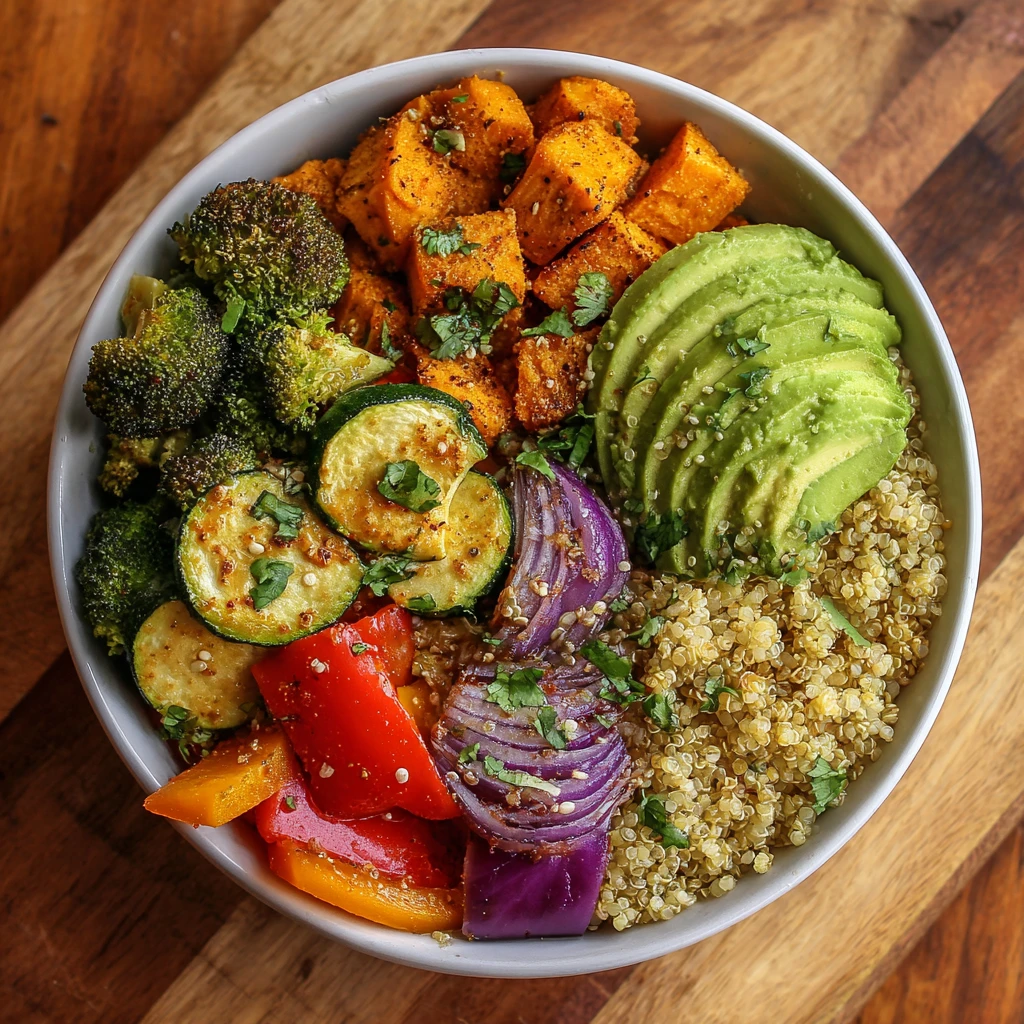
Frequently Asked Questions (FAQ)
- Can I make quinoa and roasted vegetable bowls ahead of time?
Yes, absolutely! Quinoa and roasted vegetables can both be made ahead of time and stored in the refrigerator for up to 3-4 days. Assemble the bowls just before serving.
- How do I reheat roasted vegetables?
The best way to reheat roasted vegetables is in the oven at 350°F (175°C) for about 10-15 minutes, or until heated through. You can also reheat them in a skillet over medium heat.
- Can I freeze quinoa and roasted vegetables?
While you can freeze quinoa and roasted vegetables, the texture of the vegetables may change slightly. For best results, freeze them separately in airtight containers. Quinoa can be frozen for up to 2-3 months, and roasted vegetables for up to 1-2 months.
- What other grains can I use instead of quinoa?
If you don’t have quinoa on hand, you can use other grains such as rice, farro, or couscous.
- What if I don't have olive oil?
You can use other oils for roasting vegetables, such as avocado oil, coconut oil, or vegetable oil.
Ingredients
- 1 cup quinoa
- 2 cups water or broth
- 1 sweet potato, cubed
- 1 red bell pepper, chopped
- 1 zucchini, chopped
- 1 red onion, sliced
- 2 cups broccoli florets
- 2 tablespoons olive oil
- Salt and pepper to taste
- 1 teaspoon garlic powder
- 1 teaspoon paprika
- 1 can (15 ounces) chickpeas, drained and rinsed
- 1 avocado, sliced
- 1/4 cup fresh cilantro, chopped
- Lemon-tahini dressing (tahini, lemon juice, garlic, water, salt, pepper)
